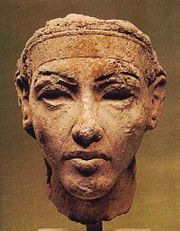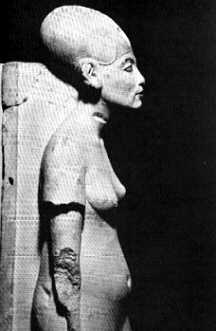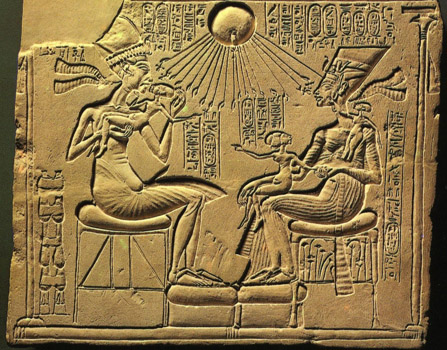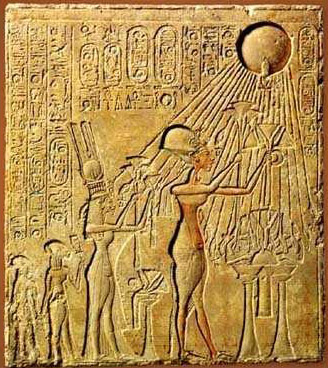|
Tony Forgey - Akhenaten: Mysteries and Speculations

Akhenaten
Style of Thutmose
The heretic king Akhenaten is bathed in controversy, mystery, and speculation.
He took the Egyptian throne in 1352 B.C. after his father Amenhotep
the III. Immediately, he began to make radical changes in religion,
art, and foreign policy. Akhenaten changed his name from Amenhotep IV,
and proceeded to radically change the Egyptian religious system from
polytheistic to monotheistic worship of one god—Aten:
Art of the culture also changed immensely, now instead of portraying
people ideally with perfect physiques,
people were portrayed with brutal honesty:

Nefertiti in her later years
It is speculated that Moses, who was alive at the time, may have
influenced Akhenaten’s religious reforms. Also, it has been theorized
that Akhenaten tried to erase the prevailing god Amun and instill his
god Aten to relinquish the growing power and wealth of the priests of
the time. Some believe that Akhenaten was just at the right place at
the right time, and whether or not he had been at the throne these reforms
would have happened. Though, most believe because of the violent reactions
after his untimely death, that Akhenaten was a crucial piece in the
religious changes that took over Egypt during his 18-year reign.
The radical changes in Egyptian art also have many theories and
mysteries. After Akhenaten took the throne, art became very realistic,
and his whole family would be in many of the pictures with him:

Stele of Akhenaten and Family
Not to mention, Akhenaten’s appearance itself is extremely strange
and unconventional. He is portrayed has having long arms and fingers,
rounded thighs, large breasts, a long neck, and a sharp chin--definitely
not an ideal physique. It is thought that he may have suffered from
Froehlich’s Syndrome (a disease of the endocrine system), or more probably
Marfan’s Syndrome. This would account for his unusual stature, as well
as his death.
After Akhenaten’s death in 1336 B.C., he was succeeded by Smenkhkara,
who may have been Nefertiti (Akhenaten’s wife) posing as a man, or may
have been the brother of Tutankhaten (King Tut). Regardless, life in
Egypt went back to normal. Religion went back to polytheistic worship
with Amun being the head god, art went back to the traditional style
(though it would be influenced by the Amarna period), and Akhenaten
was basically erased from Egyptian history. Akhenaten called himself
Wa-en-Re, "the unique one of Re", and though after his time
he was shunned as a rebel, he is certainly an extremely unique and mysterious
figure of Egyptian history.
|



